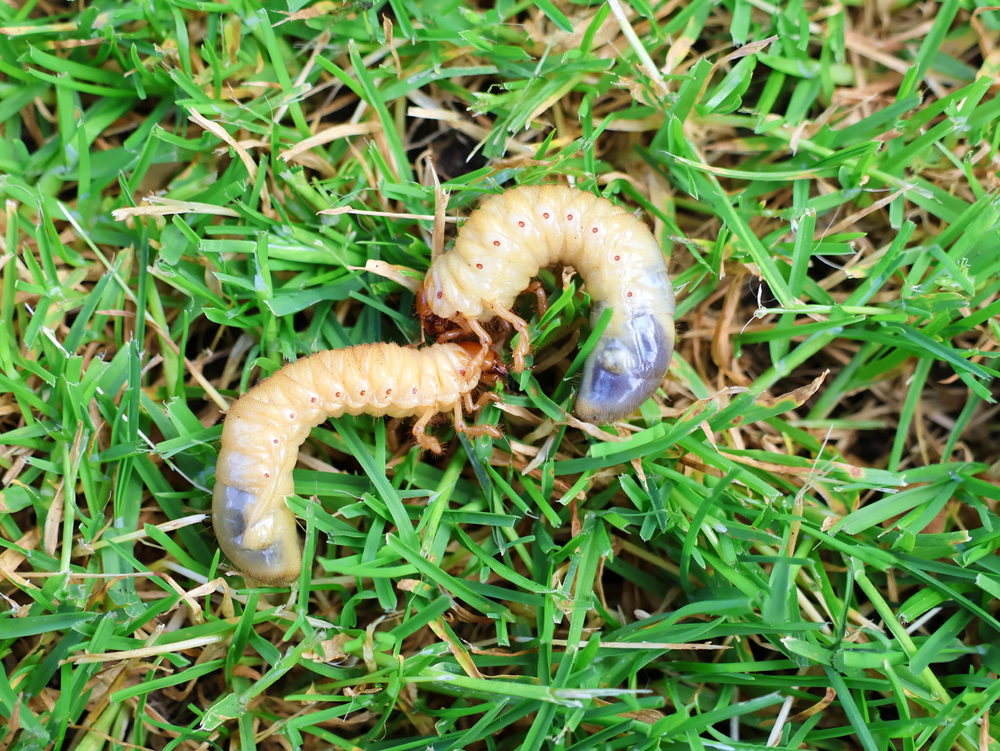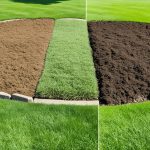Homeowners often discover strange creatures in their soil and wonder about their impact on lawn health. The term “lawn worm” refers to various species that inhabit garden soil, including both beneficial earthworms and destructive pests like grub worms, which are actually beetle larvae.
Lawn worms encompass several different species, from helpful earthworms that improve soil structure to harmful grubs that feed on grass roots and damage lawns.
Understanding the distinction between these species becomes essential for proper lawn care, as some contribute to healthy soil whilst others can destroy entire sections of turf.
This identification challenge affects millions of British gardens each year. Learning to recognise different types, assess their effects on grass health, and implement appropriate management strategies will help maintain a thriving lawn throughout the growing season.
Defining Lawn Worms and Their Role in Lawns
Lawn worms encompass several distinct species that inhabit soil beneath grass surfaces, each serving different functions within lawn ecosystems. These organisms range from beneficial earthworms that enhance soil health to pest species that can damage grass roots and leaves.
What Is a Lawn Worm?
The term “lawn worm” refers to various invertebrate species found in lawn soil environments. These organisms include true earthworms, which are segmented worms that live permanently in soil, as well as larval insects that temporarily inhabit lawn areas.
Most lawn worms measure between 2-15 centimetres in length, though some earthworm species can grow significantly larger. Their colours range from pale pink to reddish-brown, with bodies that are either segmented or caterpillar-like depending on the species.
Common characteristics include:
- Soft, elongated bodies
- Soil-dwelling habits
- Direct impact on grass health
- Seasonal activity patterns
These creatures spend most of their lives underground, moving through soil layers and interacting with grass root systems. Their presence often indicates specific soil conditions, moisture levels, and organic matter content.
Lawn Worms Versus Earthworms
Earthworms represent the beneficial subset of organisms commonly called lawn worms. True earthworms are segmented annelids that permanently reside in soil, whilst other “lawn worms” may be temporary inhabitants or pest species.
Earthworms have distinct segments along their bodies and produce nutrient-rich castings as waste products. They breathe through their skin and require moist soil conditions to survive.
In contrast, pest species like sod webworms are actually moth larvae with caterpillar-like appearances. These larvae have distinct heads, legs, and eventually transform into flying insects. Chinch bugs, despite being called “worms” colloquially, are actually small insects with wings and six legs.
The key distinction lies in their impact on lawns: earthworms improve soil structure and fertility, whilst pest species typically damage grass by feeding on roots or leaves.
Types of Lawn Worms
Beneficial Earthworms live deep in soil and can reach lengths of several feet in some species. These worms have reddish-brown to pale pink colouration and segmented bodies. They create permanent tunnel systems that improve soil structure.
Sod Webworms are cream-coloured larvae with caterpillar-like bodies measuring 1-2 centimetres long. They remain near the soil surface and feed on grass blades during night hours. These larvae eventually develop into lawn moths.
Chinch Bugs are small black insects with white wings, measuring approximately 3-4 millimetres in length. Despite the name, they are not worms but sap-sucking insects that target grass stems and leaves.
Each type exhibits different feeding habits, lifecycle patterns, and seasonal activity levels. Proper identification requires examining body structure, size, colour, and location within the lawn ecosystem.
Essential Functions in Lawn Ecosystems
Beneficial earthworms perform several vital functions that maintain healthy soil conditions. They consume organic matter and produce castings that contain concentrated nutrients, making fertiliser more readily available to grass roots.
Their tunnelling activities create air pockets that improve soil aeration and water infiltration. These tunnels allow grass roots to penetrate deeper into soil layers, accessing more nutrients and moisture during dry periods.
Earthworms also break down thatch layers by consuming dead plant material. This process prevents excessive thatch buildup that can harbour diseases and impede water movement through soil.
The presence of earthworms indicates balanced soil chemistry, adequate moisture levels, and sufficient organic matter content. Lawns with active earthworm populations typically exhibit better drought resistance, improved nutrient cycling, and enhanced overall grass health compared to worm-free environments.
Harmful and Beneficial Lawn Worm Species
Lawn worms encompass several distinct species that affect grass health in dramatically different ways. Some larvae damage grass roots and stems whilst others improve soil structure and nutrient availability.
White Grubs and Chafer Grubs
White grubs represent the larval stage of various adult beetles including chafer beetles, Japanese beetles, and European chafer beetles. These C-shaped insect larvae live beneath the soil surface and feed directly on grass roots.
Physical characteristics:
- Cream or white coloured bodies measuring 10-40mm long
- Brown heads with visible mandibles
- Six distinct legs near the head region
- Curved body shape when disturbed
White grubs cause significant lawn damage by severing grass roots during their feeding activity. Affected areas develop brown patches that easily lift from the soil like loose carpet. The damage typically appears most severe during late summer and early autumn.
Chafer grubs follow similar feeding patterns but tend to create larger damaged areas. These larvae remain active for 1-3 years depending on the species before pupating into adult beetles.
Signs of white grub infestation include increased bird and badger activity as these animals dig to reach the larvae. Damaged turf feels spongy underfoot and shows irregular brown patches that expand over time.
Cutworms and Armyworms
Cutworms and armyworms are caterpillars that represent the larval stage of various moth species. These lawn pests feed on grass blades and stems, creating distinct damage patterns across affected lawns.
Cutworm characteristics:
- Grey, brown, or black colouring with smooth skin
- Length ranges from 20-50mm when fully grown
- Curl into a C-shape when disturbed
- Feed primarily during night hours
Cutworms cut grass stems at soil level, creating small circular bare spots throughout the lawn. They typically attack individual plants rather than feeding in large groups.
Armyworm identification:
- Green, brown, or yellow striped caterpillars
- Move in large groups across lawn surfaces
- Feed during daylight hours unlike cutworms
- Create irregular patches of damaged grass
Armyworms earn their name by moving across lawns in coordinated groups, consuming grass blades and leaving behind stubble-like remains. These insect larvae can strip entire lawn sections within days during peak activity periods.
Both species cause rapid grass destruction but respond to different control methods due to their varying feeding habits and activity times.
Crane Fly Larvae (Leatherjackets)
Leatherjackets are the larval stage of crane flies, commonly known as daddy longlegs. These greyish-brown larvae live in soil and feed on grass roots, organic matter, and sometimes grass stems near the soil surface.
Leatherjacket features:
- Tough, leather-like skin texture
- Grey-brown colouration without distinct head
- Cylindrical body shape measuring 25-45mm
- No visible legs or obvious head capsule
These crane fly larvae cause lawn damage by eating grass roots and creating brown, thinning patches. The damage appears gradually over several months rather than the rapid destruction seen with other lawn pests.
Leatherjackets thrive in moist soil conditions and poorly drained areas. They remain most active during spring and autumn months when soil temperatures favour their development.
Damage symptoms include:
- Gradual lawn thinning rather than sudden brown patches
- Increased bird activity as starlings and crows seek larvae
- Soft, spongy areas where root systems have been compromised
- Small holes in the turf surface from bird feeding
The larvae pupate in late spring, emerging as adult crane flies during summer months. Heavy infestations can significantly weaken grass root systems, making lawns more susceptible to drought stress and other problems.
Giant Lawn Worms: Myths and Realities
Giant lawn worms often refer to exceptionally large earthworm species rather than a specific pest category. Common European earthworms can reach lengths of 15-30cm, whilst some species grow even larger under favourable conditions.
Large earthworm species:
- Lumbricus terrestris (common earthworm): reaches 15-35cm
- Aporrectodea longa: grows up to 15cm in length
- Various nightcrawler species: can exceed 25cm when extended
These large earthworms benefit lawn health by aerating compacted soil and processing organic matter. They create vertical burrows that improve water infiltration and root penetration throughout the soil profile.
Giant earthworms produce more visible worm casts than smaller species, which can create cosmetic issues on fine turf areas. However, their soil improvement benefits far outweigh any aesthetic concerns.
Beneficial activities:
- Enhanced soil drainage through deep burrow systems
- Increased nutrient availability from organic matter breakdown
- Improved soil structure and aggregation
- Natural thatch reduction through organic matter processing
Some gardeners mistake large earthworms for harmful pest species due to their size. Unlike destructive larvae, earthworms do not feed on living plant material and instead consume decaying organic matter and soil particles.
The presence of large earthworms indicates healthy soil conditions with adequate moisture and organic matter content.
Recognising Signs and Effects of Lawn Worm Activity
Lawn worm activity produces visible signs that can impact grass health and appearance. These effects range from beneficial soil improvements to cosmetic issues that concern homeowners.
Thinning Grass and Bare Patches
Several types of worms can cause grass to thin or develop bare patches. Cutworms, which are moth larvae, cut through grass stems at soil level causing immediate visible damage.
These destructive worms create irregular brown spots across lawns. The damaged areas often appear overnight as cutworms feed during darkness.
Root-feeding grubs also contribute to thinning grass by consuming grass roots underground. This weakens plants and makes them susceptible to disease and environmental stress.
Signs of worm damage include:
- Brown circular patches
- Grass that pulls up easily
- Areas where turf feels spongy
- Increased bird activity (birds feeding on worms)
The damage becomes more apparent during dry periods when stressed grass cannot recover. Affected areas may expand if worm populations remain unchecked.
Worm Casts and Their Impact
Worm casts appear as small, dark, crumbly mounds on the soil surface. These deposits are earthworm waste products that accumulate after feeding and digestion.
Casts create an uneven surface on fine lawns and can be particularly noticeable on closely mown grass. They may make mowing difficult and create an untidy appearance.
The frequency of cast appearance increases during wet conditions when earthworms are more active. Heavy rainfall brings worms closer to the surface, resulting in more visible casting.
Positive aspects of worm casts:
- Rich in nitrogen, phosphorus, and potassium
- Improve soil structure
- Provide slow-release nutrients
Negative aspects include:
- Surface irregularities on lawns
- Muddy conditions when wet
- Potential slip hazards on paths
Cast production varies by earthworm species and soil conditions. Some gardeners view them as beneficial whilst others consider them unsightly.
Effects on Grass Growth and Soil Fertility
Earthworm activity significantly influences soil fertility through nutrient cycling and soil structure improvement. Their tunnelling creates channels that improve water infiltration and root penetration.
Worm castings release nutrients gradually, providing sustained feeding for grass roots. This natural fertilisation process reduces dependency on synthetic fertilisers.
Soil improvements from earthworm activity:
- Enhanced drainage
- Better air circulation
- Increased organic matter content
- Improved pH balance
However, excessive earthworm populations can sometimes lead to soil compaction in certain conditions. Waterlogged soils may become more compacted when too many worms are present.
The tunnels created by earthworms help grass develop deeper root systems. This improves drought resistance and overall lawn resilience.
Soil fertility increases as earthworms break down organic matter and incorporate it into the soil profile. This process makes nutrients more available to grass plants throughout the growing season.
Lawn Worm Management and Prevention Strategies
Effective lawn worm management combines biological controls, cultural practices, targeted nematode applications, and chemical treatments when necessary. These approaches work together to reduce grub populations whilst maintaining healthy grass growth.
Natural Predators and Biological Controls
Birds serve as primary natural predators for lawn worms, particularly starlings, blackbirds, and robins. These birds actively hunt grubs near the soil surface during early morning hours.
Ground beetles and spiders also consume lawn worm larvae throughout the growing season. Creating habitats for these beneficial insects helps maintain natural pest control balance.
Encouraging bird activity through bird baths and feeding stations increases predation pressure on grub populations. However, birds may cause temporary lawn damage whilst digging for grubs.
Parasitic wasps attack adult beetles before they lay eggs. These wasps require diverse flowering plants nearby to establish stable populations in garden environments.
Natural predators work most effectively when grub populations remain moderate. Severe infestations typically require additional management approaches beyond biological controls alone.
Cultural Practices for Prevention
Regular lawn care practices significantly reduce grub susceptibility and infestation severity. Proper fertilisation strengthens grass root systems against grub feeding damage.
Reducing thatch buildup through regular raking removes organic matter that attracts egg-laying beetles. Thatch layers exceeding 1.2 centimetres create ideal breeding conditions for various beetle species.
Watering practices directly influence grub survival rates. Deep, infrequent watering encourages stronger root development whilst discouraging surface-feeding grubs.
Acidic soils with pH below 6.0 naturally deter some beetle species from laying eggs. Soil testing helps determine current pH levels and amendment needs.
Removing fallen leaves and grass clippings eliminates food sources for adult beetles. This simple practice reduces the likelihood of egg-laying in treated areas.
Using Nematodes for Control
Nematodes provide targeted biological control for lawn worm larvae without chemical residues. Heterorhabditis bacteriophora specifically targets chafer grubs and Japanese beetle larvae.
Application timing proves critical for nematode effectiveness. Soil temperatures between 12-20°C provide optimal conditions for nematode activity and reproduction.
These microscopic roundworms actively seek out grub larvae in soil. They enter through natural body openings and release bacteria that kill the host within 48 hours.
Nematodes remain active for approximately six weeks after application. Multiple applications may be necessary for complete grub population control during peak seasons.
Soil moisture levels must remain consistent after nematode application. Dry conditions kill beneficial nematodes before they can locate target grub populations.
Insecticides and Chemical Treatment
Insecticides containing imidacloprid provide systemic control for established grub infestations. These chemicals move through grass root systems to target feeding larvae directly.
Preventive applications work best when applied during adult beetle flight periods. Timing varies by beetle species but typically occurs between May and July.
Granular formulations offer easier application and longer residual activity than liquid sprays. Watering after application activates the chemical and moves it into the root zone.
Spot treatment of affected areas reduces chemical use whilst maintaining control effectiveness. This approach targets problem areas without treating the entire lawn surface.
Chemical treatment should be considered only after natural methods prove insufficient. Always follow label directions for application rates and timing restrictions.





